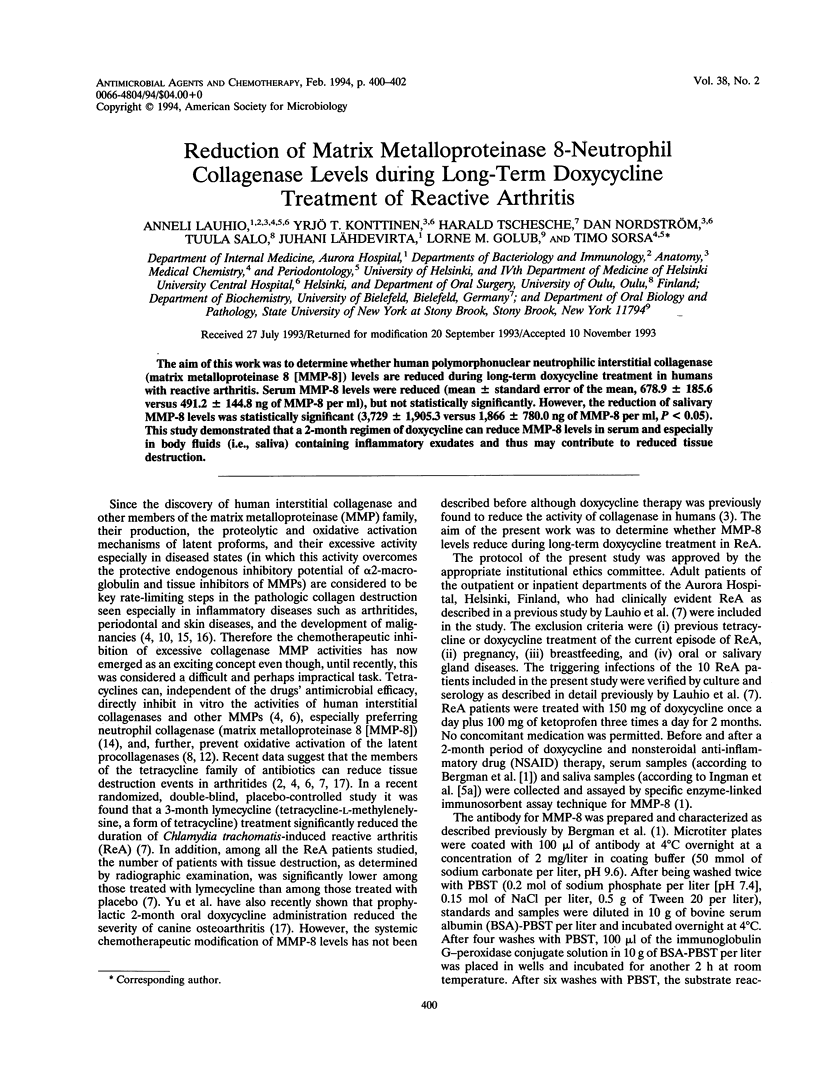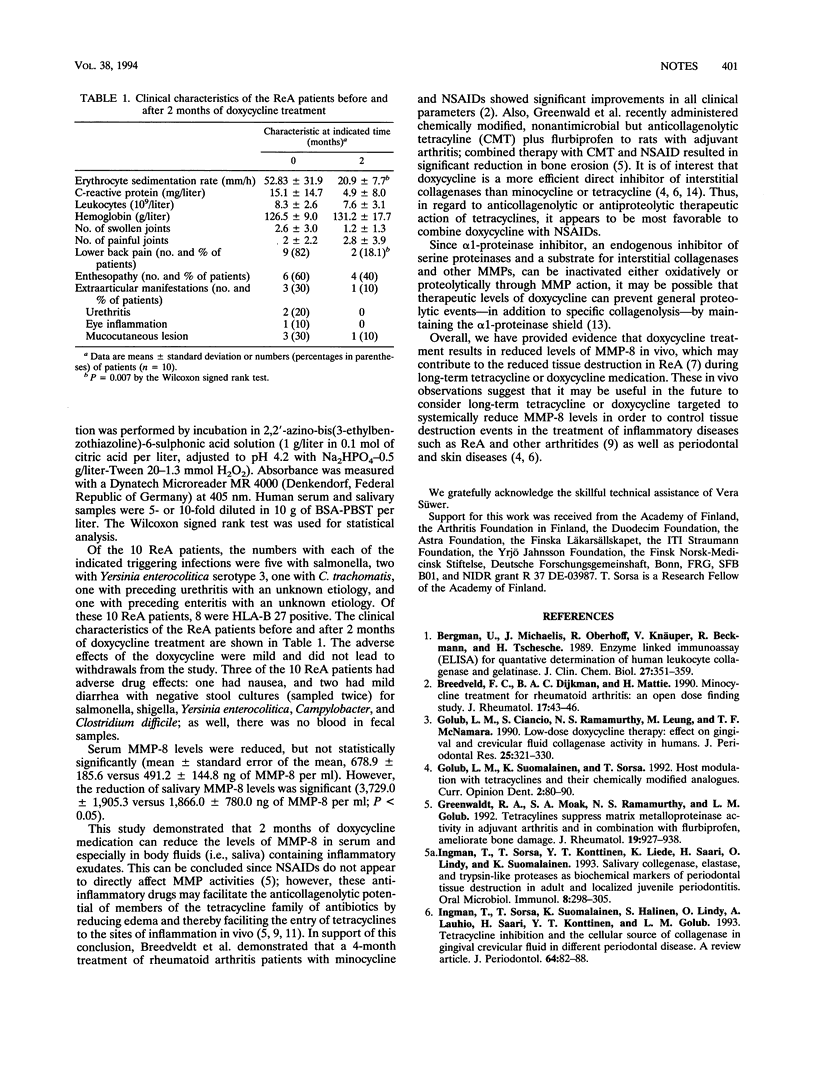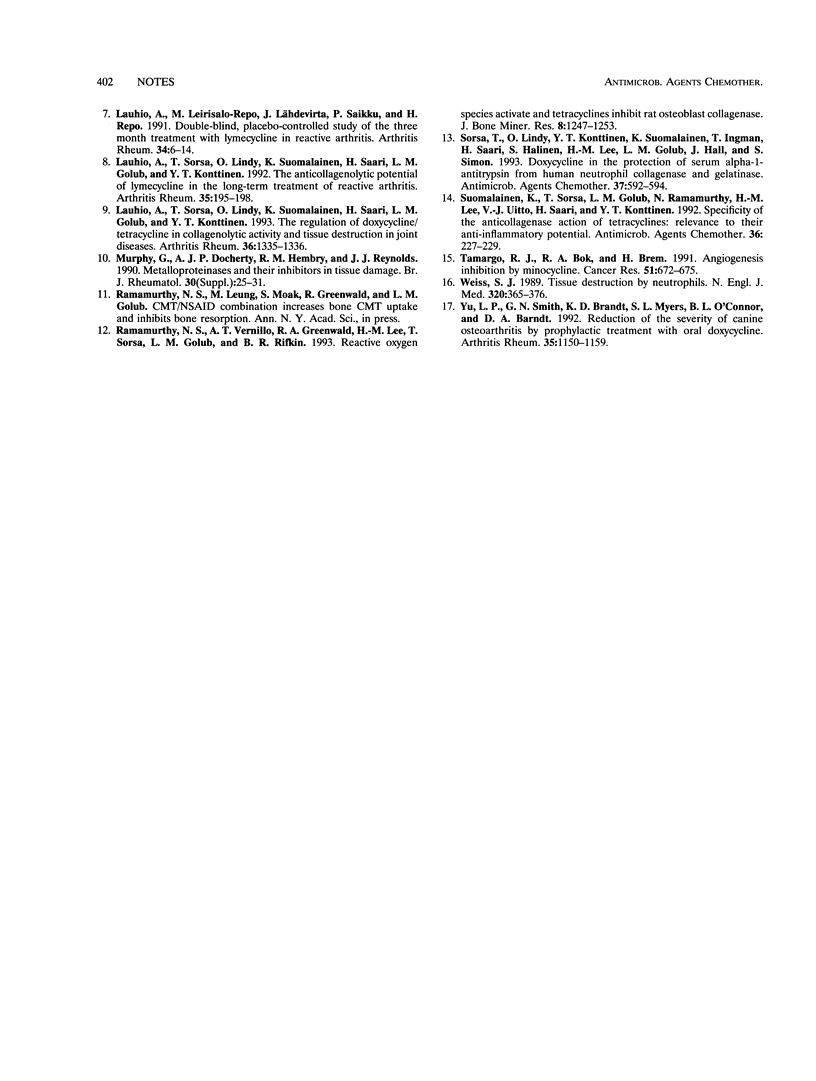Abstract
The aim of this work was to determine whether human polymorphonuclear neutrophilic interstitial collagenase (matrix metalloproteinase 8 [MMP-8]) levels are reduced during long-term doxycycline treatment in humans with reactive arthritis. Serum MMP-8 levels were reduced (mean +/- standard error of the mean, 678.9 +/- 185.6 versus 491.2 +/- 144.8 ng of MMP-8 per ml), but not statistically significantly. However, the reduction of salivary MMP-8 levels was statistically significant (3,729 +/- 1,905.3 versus 1,866 +/- 780.0 ng of MMP-8 per ml, P < 0.05). This study demonstrated that a 2-month regimen of doxycycline can reduce MMP-8 levels in serum and especially in body fluids (i.e., saliva) containing inflammatory exudates and thus may contribute to reduced tissue destruction.
Full text
PDF


Selected References
These references are in PubMed. This may not be the complete list of references from this article.
- Bergmann U., Michaelis J., Oberhoff R., Knäuper V., Beckmann R., Tschesche H. Enzyme linked immunosorbent assays (ELISA) for the quantitative determination of human leukocyte collagenase and gelatinase. J Clin Chem Clin Biochem. 1989 Jun;27(6):351–359. doi: 10.1515/cclm.1989.27.6.351. [DOI] [PubMed] [Google Scholar]
- Breedveld F. C., Dijkmans B. A., Mattie H. Minocycline treatment for rheumatoid arthritis: an open dose finding study. J Rheumatol. 1990 Jan;17(1):43–46. [PubMed] [Google Scholar]
- Golub L. M., Ciancio S., Ramamamurthy N. S., Leung M., McNamara T. F. Low-dose doxycycline therapy: effect on gingival and crevicular fluid collagenase activity in humans. J Periodontal Res. 1990 Nov;25(6):321–330. doi: 10.1111/j.1600-0765.1990.tb00923.x. [DOI] [PubMed] [Google Scholar]
- Golub L. M., Suomalainen K., Sorsa T. Host modulation with tetracyclines and their chemically modified analogues. Curr Opin Dent. 1992 Mar;2:80–90. [PubMed] [Google Scholar]
- Greenwald R. A., Moak S. A., Ramamurthy N. S., Golub L. M. Tetracyclines suppress matrix metalloproteinase activity in adjuvant arthritis and in combination with flurbiprofen, ameliorate bone damage. J Rheumatol. 1992 Jun;19(6):927–938. [PubMed] [Google Scholar]
- Ingman T., Sorsa T., Konttinen Y. T., Liede K., Saari H., Lindy O., Suomalainen K. Salivary collagenase, elastase- and trypsin-like proteases as biochemical markers of periodontal tissue destruction in adult and localized juvenile periodontitis. Oral Microbiol Immunol. 1993 Oct;8(5):298–305. doi: 10.1111/j.1399-302x.1993.tb00578.x. [DOI] [PubMed] [Google Scholar]
- Ingman T., Sorsa T., Suomalainen K., Halinen S., Lindy O., Lauhio A., Saari H., Konttinen Y. T., Golub L. M. Tetracycline inhibition and the cellular source of collagenase in gingival crevicular fluid in different periodontal diseases. A review article. J Periodontol. 1993 Feb;64(2):82–88. doi: 10.1902/jop.1993.64.2.82. [DOI] [PubMed] [Google Scholar]
- Lauhio A., Leirisalo-Repo M., Lähdevirta J., Saikku P., Repo H. Double-blind, placebo-controlled study of three-month treatment with lymecycline in reactive arthritis, with special reference to Chlamydia arthritis. Arthritis Rheum. 1991 Jan;34(1):6–14. doi: 10.1002/art.1780340103. [DOI] [PubMed] [Google Scholar]
- Lauhio A., Sorsa T., Lindy O., Suomalainen K., Saari H., Golub L. M., Konttinen Y. T. The anticollagenolytic potential of lymecycline in the long-term treatment of reactive arthritis. Arthritis Rheum. 1992 Feb;35(2):195–198. doi: 10.1002/art.1780350211. [DOI] [PubMed] [Google Scholar]
- Lauhio A., Sorsa T., Lindy O., Suomalainen K., Saari H., Golub L. M., Konttinen Y. T. The regulatory role of doxycycline/tetracycline in collagenolytic activity and tissue destruction in joint diseases: comment on the article by Yu et al. Arthritis Rheum. 1993 Sep;36(9):1335–1336. doi: 10.1002/art.1780360924. [DOI] [PubMed] [Google Scholar]
- Murphy G., Docherty A. J., Hembry R. M., Reynolds J. J. Metalloproteinases and tissue damage. Br J Rheumatol. 1991;30 (Suppl 1):25–31. [PubMed] [Google Scholar]
- Ramamurthy N. S., Vernillo A. T., Greenwald R. A., Lee H. M., Sorsa T., Golub L. M., Rifkin B. R. Reactive oxygen species activate and tetracyclines inhibit rat osteoblast collagenase. J Bone Miner Res. 1993 Oct;8(10):1247–1253. doi: 10.1002/jbmr.5650081013. [DOI] [PubMed] [Google Scholar]
- Sorsa T., Lindy O., Konttinen Y. T., Suomalainen K., Ingman T., Saari H., Halinen S., Lee H. M., Golub L. M., Hall J. Doxycycline in the protection of serum alpha-1-antitrypsin from human neutrophil collagenase and gelatinase. Antimicrob Agents Chemother. 1993 Mar;37(3):592–594. doi: 10.1128/aac.37.3.592. [DOI] [PMC free article] [PubMed] [Google Scholar]
- Suomalainen K., Sorsa T., Golub L. M., Ramamurthy N., Lee H. M., Uitto V. J., Saari H., Konttinen Y. T. Specificity of the anticollagenase action of tetracyclines: relevance to their anti-inflammatory potential. Antimicrob Agents Chemother. 1992 Jan;36(1):227–229. doi: 10.1128/aac.36.1.227. [DOI] [PMC free article] [PubMed] [Google Scholar]
- Tamargo R. J., Bok R. A., Brem H. Angiogenesis inhibition by minocycline. Cancer Res. 1991 Jan 15;51(2):672–675. [PubMed] [Google Scholar]
- Weiss S. J. Tissue destruction by neutrophils. N Engl J Med. 1989 Feb 9;320(6):365–376. doi: 10.1056/NEJM198902093200606. [DOI] [PubMed] [Google Scholar]
- Yu L. P., Jr, Smith G. N., Jr, Brandt K. D., Myers S. L., O'Connor B. L., Brandt D. A. Reduction of the severity of canine osteoarthritis by prophylactic treatment with oral doxycycline. Arthritis Rheum. 1992 Oct;35(10):1150–1159. doi: 10.1002/art.1780351007. [DOI] [PubMed] [Google Scholar]


